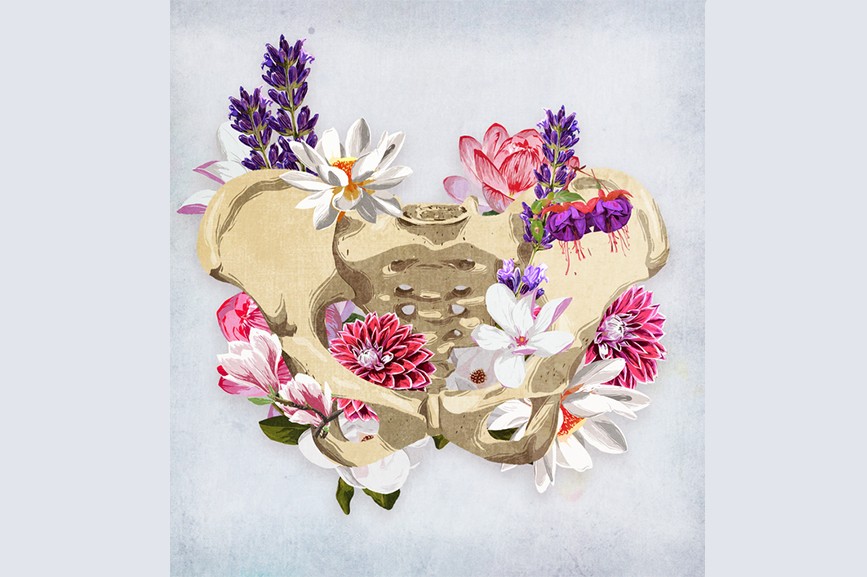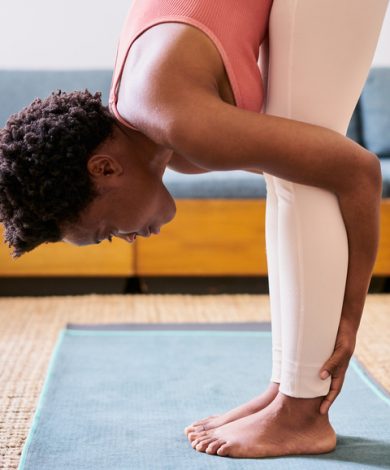I'm fascinated by relaxin. If you’re not familiar, it’s a hormone produced during pregnancy to…
Body
Your Pelvic Floor Needs Love No Matter Your Birth Experience. Everything You Need to Know.
June 14, 2021 • By Alissa Alter

Too many women don’t know what or where their pelvic floor is until after they gave birth. This actually makes me angry. We deserve to know and understand what the heck is happening in our bodies always. Especially when it comes to growing and birthing a tiny human.
So that’s why I have to tell you what’s going on. Because we should have learned this before we got our periods, before we started having sex, and definitely before we started having babies.
So here we go. Get ready to meet your pelvic floor.
Your pelvic floor is a hammock of muscles at the base of your pelvis. These muscles house your external digestive and reproductive organs and support your internal digestive and reproductive organs. They actually support all of the organs in your trunk because all of that weight is held up by your pelvic floor.
So when you get pregnant, grow a new organ, grow a human, and your uterus expands like 500x its original size, your pelvic floor has a lot of work to do to support everything. AND THEN… It’s supposed to stretch and release and open to gracefully allow the baby to glide out of your birth canal.
So here’s the thing. Healthy muscles can both fully contract (supporting all of those organs new and old, and the baby) and fully release (allowing the baby to slide out of your vag). While I’m obviously kidding when it comes to the ‘gliding’ and ‘sliding’ part, the rest of this is true.
Healthy muscles can do this. And in order to have healthy muscles, we need to train them in all ranges of motion, challenge them in new ways and know how to recruit them. If you’re picking up what I’m laying down, you might be asking yourself… “Who is going into pregnancy and childbirth with a healthy pelvic floor if none of us even know what or where it is?”
I know. I get it. I see you. And that’s what I’m here for. As stated above, healthy muscles in your pelvic floor hold the baby in when engaged and let the baby out when fully released. This healthy balance also allows you to:
- hold in urine when you sneeze and pee when you sit on the toilet
- hold in a fart when you need to, and let ‘er rip when you’re ready
- support your core body (pelvis, abdominals, and spine) and have pleasurable, pain free sex and penetration
What I see so often when working with clients during pregnancy and postpartum is that the load of pregnancy overworks the muscles of the pelvic floor.
These muscles are not only supporting ALL of your organs, they are supporting the baby and their organs, your new organ (the placenta), the amniotic fluid, and everything else. The pelvic floor is also compensating for the lack of stability in your body caused by the hormone relaxin which you can read about here.
With the added load and destabilization of pregnancy, your pelvic floor muscles are working overtime. Overworking. In constant engagement and contraction. That constant work easily turns into tension which builds on tension on top of tension, etc.
This is why every prenatal class you went to told you to release your pelvis, relax your pelvic floor, and open your hips. There needs to be equal focus on the release to balance all of the contraction to train and maintain healthy muscles.
Unless you are working with a pelvic floor PT or someone who specializes in pelvic health, most of us go into childbirth with some additional tension downstairs. It doesn’t help that when we are nervous, anxious, or scared and the sympathetic nervous system kicks in (fight or flight), your pelvic floor muscles tighten to keep you from eliminating (that’s my polite way of saying peeing or pooping).
Ok, so we get it that pregnancy can cause some tension in the PF, right? Great. So then you give birth to a baby. Whether you have a vaginal or belly birth, your pelvic floor is compromised from pregnancy. So let’s talk about each type of birth and its unique impact on your undercarriage.
For a belly birth/cesarean:
Fascia runs all through our bodies. It wraps around our muscles and tendons and everything. It’s like the connective tissue for our connective tissues. Like internal saran wrap. Fascia that is present in your pelvic floor extends up and across your abdomen. And when this is cut during birth and then repaired, it gets wonky.
Think about a sheet of saran wrap. If you were to cut an area and then try to sew it again. It gets snarled and tangled. And like saran wrap, it extends through the entire sheet and makes a bit of a mess. This is why it’s important to massage your scar and your abdomen after you’ve healed. To mobilize, untangle, iron out the internal tissues to release tension. Massaging your scar can benefit the state of your pelvic floor. And vice versa. Massaging the pelvic floor and mobilizing these muscles can help soften abdominal tension.
For a vaginal birth:
Again, we are coming into this with some extra tension downstairs and hopefully, someone along the way mentioned stretching, massaging, releasing these muscles with your breath. Then, the muscles of your vagina (the birth canal) and the vaginal opening stretch enough for a human to fit through. Potentially, the surrounding muscles of the pelvic floor were torn.
Tearing can occur in the perineum (this is spoken about most often and extends back toward your anus). BUT! It can also occur in your labia (out to the sides) or toward/through the urethra (up to the top). Have you ever rolled your ankle? Or overstretched your hamstrings or shoulders? Do you remember what happened after? Everything got super tight.
When muscles are overstretched or overextending, they react by guarding. The muscles shorten and tighten (a full-out spasm) in order to inhibit movement to avoid further injury. Make sense? So your pelvic floor has been functioning with a little added tension in pregnancy to hold up the baby and your guts. Then, these muscles are overstretched to the nth degree. And then, the muscles get scared it will happen again and tighten up to protect you.
In both scenarios:
Everyone you talk to tells you to do kegels to tighten up your vag and make sure you don’t pee your pants. Based on what you know from reading this, would tightening an already tight muscle help restore healthy function? NO! You need to engage AND release! It’s not that engaging is bad, it’s that the yang needs the yin. The pull needs the push. The salty needs the sweet.
We learn through contrast. So we can use this tension as a guide to letting some of it go. To feel something different in our new, sore, swollen postpartum bodies. Are you ready for me to really blow your mind? Maybe I shouldn’t. JK I’m totally going to.
Your pelvic floor is made up of a collection of muscles. They work together as a team. And like any winning team, each player is pulling their weight (see what I did there?) We want to make sure all of the team members are showing up fully and performing to their highest potential right? Right. The team is only as strong as its weakest player.
Are you ready for all of your pelvic floor dreams to come true? The muscles that hold in urine are different from the muscles that hold in a tampon which are still different from the ones that hold in farts. I refer to these as the muscles of the P hole, V hole, and B hole. For simplicity’s sake of course.
I now invite you to get to know the muscles of your P hole, V hole, and B hole. Ready? Ok!
- Take a deep inhale, feel your belly expand, maybe feel some extra space in your pelvic floor.
- As you exhale squeeze and lift your P hole (where the pee comes our aka the urethral sphincter). This falls under the category of a classic Kegel exercise. Please do not actually stop your flow of urine when using the toilet because it can create an unhealthy relationship between your brain and body and you could end up with potty problems.
- Next! Inhale again, feel your belly expand, feel some extra space in your pelvic floor.
- Exhale and close your V hole (the vaginal opening) and imagine you were picking up a marble with your vagina. So it’s a close and lift situation. Like the claw in Toy Story. If you notice your butt cheeks (glutes) clenching you’re doing too much. There should be no butt stuff happening. All vagina stuff.
- Last and final stop! Inhale again, feel your belly expand, feel some extra space in your pelvic floor.
- This time as you exhale close and lift your B hole (anal sphincter) as if you are trying to hold ina tiny fart while spooning with a new(er) romantic partner and you’re the little spoon and you don’t want them to know you’re holding in a fart. We’ve all been there right?
I make jokes because handling all of this is hard enough. We don’t need to make it any harder. And because we are so often told to strengthen our pelvic floor postpartum when really we need to release tension, articulate muscles, and find movement. We need this physically, mentally, and emotionally.
Also because I tore my whole B hole giving birth to my son. And while it’s supportive for me to do kegels (focusing on the P hole as they are an important team member), I’m grateful that I knew how to isolate, focus, engage, release, and rehabilitate my B hole.
I hope you had as much fun as I did on this pelvic floor adventure. Looking to get even more intimate? Do this breathing and engaging exercise while using a hand mirror! You can literally see the muscles engaging and releasing! Or not doing it!
Curious why everyone keeps saying you need to breathe? Ready to harness the power of your breath as the magical solution to almost everything, check out this article.
Want to learn even more? Check out our upcoming events.
And always remember, I’ve got your back. I’ve got your front. And I’ve got your undercarriage.



